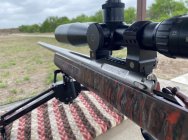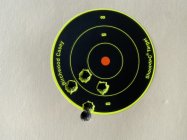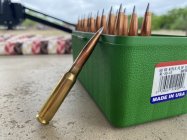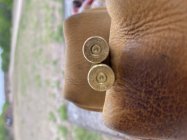You are using an out of date browser. It may not display this or other websites correctly.
You should upgrade or use an alternative browser.
You should upgrade or use an alternative browser.
250gr A Tip in a 308
- Thread starter APGE
- Start date
How are you calibrating your PT? I bought one but haven't bothered to mess with it because I've been told it's useless without calibration to a known standard, which I can't do (I don't have access to test cartridges, and they don't exist for Dasher or BRA).People who go places like this should invest in a Pressure Trace and stop reading the tea leaves of primer flattening and theoretical pressures from apps. I did.
XTR
F-TR obssessed shooting junkie
Depends on what you want to know. To a percentage of people on the interwebs it would be useless w/o an ASTM calibration... they are just like that.
Me on the other hand, I test against known loads in my 308. Oddly enough it reports my 200.20x loads at in the mid 2600s FPS with sufficient freebore at about 55 to 58k if memory serves me. When compared to the basically infinite brass life I get, that seems to correlate.
If I am loading say 215s or some solid with some powder combination that doesn’t exist on any table then to start working up a load I can test fire known loads for a pressure datapoint and then test the new load.
The system when set up with accurate inputs is supposed to report with reasonable accuracy. Because the system measures strain on the outside of the barrel one of the things yo try to do is to install the strain gauge in a spot where the thickness is consistent for about a quarter of an inch on either side, that is hard to get in short cases. if you do try to set yours up on your 6 you might try just in front of the neck. I believe I’ve read somewhere that is actually how some testing is done in Europe.
they are also priceless for development of loads for smokeless muzzle loaders where we do really scary stuff like duplex loads, or drop a few grains of a fast booster under a slower powder to get pressure up.
Me on the other hand, I test against known loads in my 308. Oddly enough it reports my 200.20x loads at in the mid 2600s FPS with sufficient freebore at about 55 to 58k if memory serves me. When compared to the basically infinite brass life I get, that seems to correlate.
If I am loading say 215s or some solid with some powder combination that doesn’t exist on any table then to start working up a load I can test fire known loads for a pressure datapoint and then test the new load.
The system when set up with accurate inputs is supposed to report with reasonable accuracy. Because the system measures strain on the outside of the barrel one of the things yo try to do is to install the strain gauge in a spot where the thickness is consistent for about a quarter of an inch on either side, that is hard to get in short cases. if you do try to set yours up on your 6 you might try just in front of the neck. I believe I’ve read somewhere that is actually how some testing is done in Europe.
they are also priceless for development of loads for smokeless muzzle loaders where we do really scary stuff like duplex loads, or drop a few grains of a fast booster under a slower powder to get pressure up.
At 3.1 OAL and 2650 fps, GRT predicts 58.7 kpsi, so well within the ballpark of what you report.Davidjoe - FWIW, for a typical 2650 fps F-TR load velocity from a 30" barrel, QuickLoad predicts pressures in the 61-62K psi range for the 200.20X bullet over Varget in Palma brass with the bullet seated at a COAL of 3.100" to 3.120",
I can appreciate knowing what the actual number is, and a reliable way to find out. Basically necessary for manufacturers to have booked this data thoroughly. But it would be hard for me, at least, to not soon circle back to what the brass and primers are saying. Supposing for example, the gauge tells me I’m high, but I have an excellent load that has been working with no signs of pressure and expected reload count life, ... do I keep it or reduce it, it’s a tough question that would have me ask myself, what would I have done without the number.
Kind of similar to my scale reading 215 at 6’-3”. On the one hand, that could be really good if I have been hitting the weights, but if I had been slacking off for a long time, the same 215 on the scale could now be fat instead of muscle, point being that it would be really hard for me to get away from relying on the physical indicators.
I agree though that it would be a useful piece filling out the full picture.
Kind of similar to my scale reading 215 at 6’-3”. On the one hand, that could be really good if I have been hitting the weights, but if I had been slacking off for a long time, the same 215 on the scale could now be fat instead of muscle, point being that it would be really hard for me to get away from relying on the physical indicators.
I agree though that it would be a useful piece filling out the full picture.
This is a fun read. I love cheating with in the rules. NASCAR had a rule in the 1970's that regulated the size of the fuel cell, (308 case) so everybody had to make the same amount of pit stops for fuel. However they failed to write a rule about the fuel line. Smokey Yunick snakes a 100 yards of 1 inch fuel line all though his car, as a 2nd fuel tank, has one less pit stop than everybody else and win the race.
Sandstorm
Gold $$ Contributor
I remember that...dangthe race.
Good old American ingenuity and creativity
Gotta friggin love it.
Yes, the baseline of an unmodified .308 case would be like a cubic inch displacement limiting rule in racing. Aside from the size of the case, it’s all custom to preference loads being run that aren’t constrained by the standardized specs of “.308 Winchester” commercial ammo.
At 200 yards this gun is breaking in nicely. It does not need to group at 200 like a .223 with 80 grain bullets in order to see a benefit at 1,000.
Primers are actually looking very normal now on this once fired brass.
I only neck size the top of the neck for these which in theory helps allow them to align with bore.
That target pic should be rotated in accordance with the label’s writing.
Primers are actually looking very normal now on this once fired brass.
I only neck size the top of the neck for these which in theory helps allow them to align with bore.
That target pic should be rotated in accordance with the label’s writing.
Attachments
I don’t think I could dig a post hole deep enough to cover them!Those loaded rounds look like old Russian SAM's! Freakin flying telephone poles.
Ned Ludd
Silver $$ Contributor
You know how with some really long loads you have to remove the bolt to un-chamber a round? With these you have to unscrew the barrel.Those loaded rounds look like old Russian SAM's! Freakin flying telephone poles.
What is your bullet seating force when seating bullet.
It’s actually a lot - the most of any round I load, on new brass, as I don’t opt to expand the neck. Because the first loading is so compressed, (at the upper weight of testing) I really need that bullet to hold progress, as I rotate it, lug nut tightening style, incrementally seating it, and, as Ned mentions a round might have to be unloaded on the line, sometime.
The unmeasured order of magnitude of seating force I put at 3 times the force to seat a typical bullet in a virgin case.
On my original high resolution pics before the system automatically decimates pixel count, I can easily see the outline of the neck’s stretching from the bullet’s excess diameter.
We can likely all guesstimate from reloading experience roughly what that force would be on an empty shell, by itself, to expand the neck. I’m putting that amount of pressure to merely expand the neck - as only 1/3 of the total force used to seat the bullet. The other 2/3’s of the force I use, is to compress the powder. (It’s much easier the next time around and the bullets seat straighter, as well.)
In fact the powder is so compressed the first time, that I will break seating into an initial stage and several hours later, a final one, to permit settling of kernels. Again, for virgin brass. I have even gently rapped the case heads on the reloading bench to assist that settling process, which is very helpful.
(All of this is why I’m pretty confident in that “nothing too dramatic” with H4350, reference above, as long CCI 41 primers are used with Lapua Palma. I truly don’t believe more powder can be squashed into a .308 than I have done, with any reasonable bullet retention in the case, there’s not a heavier match bullet I’m aware of, and I’m already at an 8 twist.)
Last edited:
The firing pin hole bushed would probaly stop the catering..
Had my remmy 700 done for my 6.5x47
I’m headed north four hours to Bayou in a car with only this one rifle in it. Like walking into the SAT’s with only your Mirado No. 2 pencil. I’m ready for the test. The second action’s bolt didn’t crater primers.
I’d say some more rounds through this new of Wednesday barrel would have been preferable but then again it’s just a club match and I don’t have gobs of this powder to spare.
But etargets are in use and I’ll post screen shots. For better or worse. I’ll be seeing what shooting the lowest velocity bullet in a match is like for a change. 26 miles an hour.
Ned Ludd
Silver $$ Contributor
Davidjoe - FWIW, a very long drop tube might help to settle the powder a little more and make seating easier. Even better, if you have a hand held vibrator of some kind (best option), or possibly some other electric device like a toothbrush or razor that vibrates, touching it around the edge/rim of the reloading tray holding the charged cases may settle the powder noticeably more. Good luck in the match!
Thanks for detailed replyIt’s actually a lot - the most of any round I load, on new brass, as I don’t opt to expand the neck. Because the first loading is so compressed, (at the upper weight of testing) I really need that bullet to hold progress, as I rotate it, lug nut tightening style, incrementally seating it, and, as Ned mentions a round might have to be unloaded on the line, sometime.
The unmeasured order of magnitude of seating force I put at 3 times the force to seat a typical bullet in a virgin case.
On my original high resolution pics before the system automatically decimates pixel count, I can easily see the outline of the neck’s stretching from the bullet’s excess diameter.
We can likely all guesstimate from reloading experience roughly what that force would be on an empty shell, by itself, to expand the neck. I’m putting that amount of pressure to merely expand the neck - as only 1/3 of the total force used to seat the bullet. The other 2/3’s of the force I use, is to compress the powder. (It’s much easier the next time around and the bullets seat straighter, as well.)
In fact the powder is so compressed the first time, that I will break seating into an initial stage and several hours later, a final one, to permit settling of kernels. Again, for virgin brass. I have even gently rapped the case heads on the reloading bench to assist that settling process, which is very helpful.
(All of this is why I’m pretty confident in that “nothing too dramatic” with H4350, reference above, as long CCI 41 primers are used with Lapua Palma. I truly don’t believe more powder can be squashed into a .308 than I have done, with any reasonable bullet retention in the case, there’s not a heavier match bullet I’m aware of, and I’m already at an 8 twist.)
Have you tried loading with Vit N150 also what percentage of case neck length does bullet bearing surface seat at Good Luck at Match.
The chamber on this new barrel is throated to accommodate a round where exactly 1/2 of the neck is in contact with the bearing surface of the body of the bullet. 3/4+ of the neck in contact was the spec for my first rifle. I’m seeing about 1.0 to 1-1/2 more grains of viable capacity this way.
As a reloader 1/2 neck seating is against my instincts to do, especially with so much bullet protrusion and the fact that a .308 neck is already short, but I know as a matter of logic that an F-class round need not be handled much before firing.
I haven’t tried any VV powders yet. They are a little denser generally, right, compared to H4350? It’s not a common problem that case size itself eliminates choices, but 4831SC for example could probably never work for that reason. I do have a number of varieties on hand, probably some N150, from several years back, and with shortages I may have to pull them out. I better recall 160 and 165 though.
As a reloader 1/2 neck seating is against my instincts to do, especially with so much bullet protrusion and the fact that a .308 neck is already short, but I know as a matter of logic that an F-class round need not be handled much before firing.
I haven’t tried any VV powders yet. They are a little denser generally, right, compared to H4350? It’s not a common problem that case size itself eliminates choices, but 4831SC for example could probably never work for that reason. I do have a number of varieties on hand, probably some N150, from several years back, and with shortages I may have to pull them out. I better recall 160 and 165 though.
Similar threads
- Replies
- 19
- Views
- 4,309
Upgrades & Donations
This Forum's expenses are primarily paid by member contributions. You can upgrade your Forum membership in seconds. Gold and Silver members get unlimited FREE classifieds for one year. Gold members can upload custom avatars.

Click Upgrade Membership Button ABOVE to get Gold or Silver Status.
You can also donate any amount, large or small, with the button below. Include your Forum Name in the PayPal Notes field.
To DONATE by CHECK, or make a recurring donation, CLICK HERE to learn how.

Click Upgrade Membership Button ABOVE to get Gold or Silver Status.
You can also donate any amount, large or small, with the button below. Include your Forum Name in the PayPal Notes field.
To DONATE by CHECK, or make a recurring donation, CLICK HERE to learn how.













